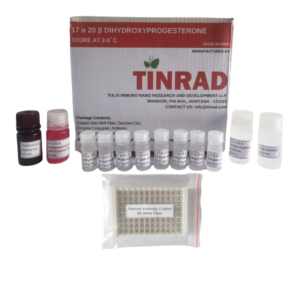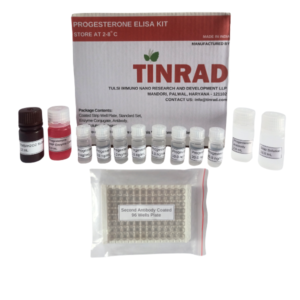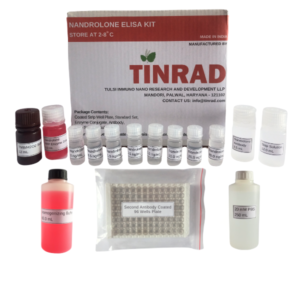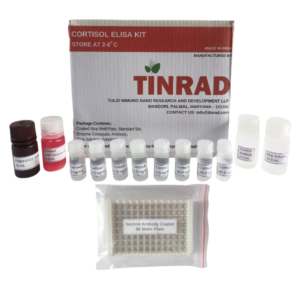Reagent Provided
Reagents are stable until the expiry date of the kit, if stored at 2-8°C.
- 17 α MT-HRP enzyme conjugate (7 mL), ready to use.
- Secondary-Ab coated –96 wells (8 well strip) ready to use.
- 17 α MT -Ab (2.5mL), ready to use.
- Eight standards (each vial with 0.5 mL of standards), ready to use. The concentration of 17 α MT ranges from 0 to 40ng/mL with 0.03% Proclin 300. The exact concentration is marked on each vial.
- TMB/H₂O₂ solution (12 mL), ready to use.
- Stop solution (12.0 mL 0.5 M H₂SO₄)
- 250 mL PBS
- 60 mL homogenizing buffer
Materials Required But Not Provided
In addition to standard laboratory equipment the following items are required
- Precision micropipette (100 µL – 1000 µL)
- Precision micropipette (10 µL – 100 µL)
- ELISA – Reader (Microtiter Plate Reader)
- Centrifuge, Balance, Glass Homogenizer, Ultrasonicator or deep fridge
Precautions
For satisfactory results:
- Do not mix reagents from different lots
- Let reagents come to room temperature before use
- Secure the desired number of coated wells in the holder.
- Dispense 20µL of 17 α MT-Ab into each well.
- Dispense 1000µL of standard followed by serum samples or tissue homogenate into appropriate wells in duplicate.
- Dispense 50µL of 17 α MT-HRP enzyme conjugate into each well.
- Keep at room temperature for 60 minutes.
- After 60 minutes remove the mixture by flicking the plate contents into a waste container.
- Fill and flick the microtiter wells 7-10 times under running tap water.
- Tap the plate 15 to 20 times on a cloth towel and ensure that water has been removed from wells.
- Dispense 100 µL of substrate solution in each well and keep at room temperature for 15 minutes.
- Stop the reaction by adding 100µL of stop solution.
- Read OD at 450 nm with a microtiter well reader immediately.
- Standards curve (sigmoid in nature). Plot standard curve on semi- logarithmic paper. Optical density or % A/Ao on the vertical axis. The 17α MT standard concentrations (ng/mL) on the horizontal axis.
- Obtaining of 17α MT concentration in samples: For each sample, locate the OD or %A/Ao on the vertical axis and read of the corresponding 17α MT concentration on the horizontal axis. It will directly show the concentration in terms of ng/mL in serum.
Ao = optical density at zero dose
A = optical density at varying concentrations of standard dose or unknown sample
% A/Ao = A/Ao X 100 - a) The minimum concentration of 17α MT, which can be detected from 0 standard, is 0.25 ng/mL (B0-2SD)
- b) The precision profile of the assay was determined from 4 quality control serum samples. The results were –

- c) Accuracy: For recovery study, different concentrations of 17α MT were added to serum sample wherein its basal concentration was already estimated. The recovery performance of the assay is given below.

- d) Specificity: The cross-reactivity of this antibody used in this kit is less than 0.1% with naturally occurring C27, C21, C19, and C18, except 5 α-DHT (10%), Testosterone (5%) and Androstendione (5%).
All blood components and biological materials should be handled as potentially hazardous. Decontaminate and dispose specimens and all potentially contaminated materials as they could contain infectious agents.
Sample Collection
Collect the blood in plain tube, separate the serum from cells by centrifugation. Store at 2-8°C, if the assay is to be performed within 24 hours. For longer storage keep frozen at – 20°C or – 8O°C after aliquoting so as to avoid repeated freezing thawing.
Tissue homogenates – Rinse the tissue in PBS (0.02mol/L, pH 7.0-7.2) to remove excess blood thoroughly and weighed 500mg before homogenization. Minced the tissues to small pieces and homogenized them in 500µL of homogenizing buffer with a glass homogenizer. The resulting suspension are subjected to either ultrasonication or to two freeze-thaw cycles to further break the cell membranes. After that, centrifuge the homogenates for 15 minutes at 1500×g (or 5000 rpm). Take out the supernatant and assay within 24 hours or aliquot and store it at -20°C or -80°C.
Assay Procedure
Let reagents come to room temperature.
Summary Of Assay Procedure

Results
17α-methyl testosterone concentration in samples are obtained from the standard curve.
Example Of 17 α Methyltestosterone Standard Curve

Specfic Performance Characteristics





